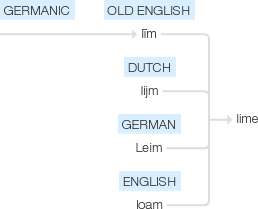Lime
Old English līm, of Germanic origin; related to Dutch lijm, German Leim, also to loam.
wiktionary
From Middle English lyme, lym, lime, from Old English līm, from Proto-Germanic *līmaz. Cognate with Saterland Frisian Liem(“glue”), Dutch lijm, German Leim(“glue”), Danish lim (from Old Norse lím), Latin limus(“mud”).
An alteration of line, a variant form of lind.
From French lime, from Spanish lima, from Arabic لِيمَة (līma), from Persian لیمو (līmū).
Back-formation from limer.
lime (plural limes)
etymonline
lime (n.1)
"chalky, sticky mineral used in making mortar," from Old English lim "sticky substance, birdlime;" also "mortar, cement, gluten," from Proto-Germanic *leimaz (source also of Old Saxon, Old Norse, Danish lim, Dutch lijm, German Leim "birdlime"), from PIE root *(s)lei- "slime, slimy, sticky" (source also of Latin limus "slime, mud, mire," linere "to smear;" see slime (n.)).
Bird-lime is prepared from the bark of the holly, it was spread on twigs and used for catching small birds. The lime used in building, etc. is made by putting limestone or shells in a red heat, which burns off the carbonic acid and leaves a brittle white solid which dissolves easily in water. Hence lime-kiln (late 13c.), lime-burner (early 14c.). As a verb, c. 1200, from the noun.
lime (n.2)
"greenish-yellow citrus fruit," 1630s, probably via Spanish lima or Portuguese limão, said to be from Arabic lima "citrus fruit," from Persian limun, in reference to the Persian lime, which might be a hybrid of the "Key" lime and the lemon; the word is perhaps from or related to Sanskrit nimbu "lime."
The Key lime indigenous to India and the Malay archipelago (Arabs introduced it to the Levant, North Africa, Spain, and Persia in the Middle Ages); compare Malay (Austronesian) limaw "lime," also, generically, "citrus fruit," which might be the ultimate source. Yule and Burnell think the English got the word from the Portuguese in India. Lime-green as a color is from 1890.
lime (n.3)
"linden tree," 1620s, earlier line (c. 1500), from Middle English lynde (early 14c.), from Old English lind "lime tree" (see linden). Klein suggests the change of -n- to -m- began in compounds whose second element began in a labial (such as line-bark, line-bast). An ornamental European tree, it is unrelated to the tree that produces the citrus fruit.
